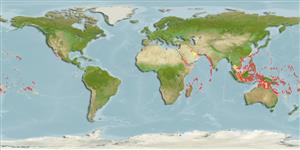Teleostei (teleosts) >
Gobiiformes (Gobies) >
Gobiidae (Gobies) > Gobiinae
Eponymy: Sir Charles Maurice Yonge CBE FRS (1899–1986) was an English marine zoologist. [...] (Ref. 128868), visit book page.
More on authors: Davis & Cohen.
Environment: milieu / climate zone / depth range / distribution range
Ecology
Marine; reef-associated; depth range 3 - 45 m (Ref. 1602). Tropical; 22°C - 26°C (Ref. 27115); 30°N - 28°S
Indo-Pacific: Red Sea to the Hawaiian and Rapa islands, north to the Ryukyu Islands, south to the northern Great Barrier Reef. Also known from outer shelf off Miyakojima, East China Sea.
Size / Weight / Age
Maturity: Lm ? range ? - ? cm
Max length : 3.5 cm SL male/unsexed; (Ref. 48637)
Dorsal spines (total): 7; Dorsal soft rays (total): 7 - 10; Anal spines: 1; Anal soft rays: 7 - 10. Characterized by semi-transparent upper body and brownish on lower; body with few evident dark bars; 3-6 lowermost pectoral rays unbranched and thickened; longitudinal scale series 26-58; cup-like pelvic fins with pocket-like thickened, folded and lobed frenum; opening of gill reaching ventrally to below base of pectoral fin (Ref. 90102).
Lives exclusively on Cirripathes anguina found along current-swept drop-offs or backreefs (Ref. 48637). Benthic (Ref. 58302). Occurs in pairs, occasionally with juvenile or a smaller female, Ref. 48637. Also found on seaward and lagoon reefs in 3-45 m (Ref 90102). Feeds on zooplanktons (Ref. 89972).
Life cycle and mating behavior
Maturity | Reproduction | Spawning | Eggs | Fecundity | Larvae
Benthic spawner. Bi-directional sex change may occur as suggested by a monogamous mating system and bisexual gonadal phase (Ref. 103751).
Myers, R.F., 1991. Micronesian reef fishes. Second Ed. Coral Graphics, Barrigada, Guam. 298 p. (Ref. 1602)
IUCN Red List Status (Ref. 130435: Version 2024-1)
Threat to humans
Harmless
Human uses
Fisheries: commercial; aquarium: commercial
Tools
Special reports
Download XML
Internet sources
Estimates based on models
Preferred temperature (Ref.
123201): 24.8 - 29.1, mean 27.7 °C (based on 550 cells).
Phylogenetic diversity index (Ref.
82804): PD
50 = 0.5000 [Uniqueness, from 0.5 = low to 2.0 = high].
Bayesian length-weight: a=0.00724 (0.00339 - 0.01546), b=3.10 (2.92 - 3.28), in cm total length, based on LWR estimates for this (Sub)family-body shape (Ref.
93245).
Trophic level (Ref.
69278): 3.2 ±0.3 se; based on size and trophs of closest relatives
Resilience (Ref.
120179): High, minimum population doubling time less than 15 months (Preliminary K or Fecundity.).
Fishing Vulnerability (Ref.
59153): Low vulnerability (10 of 100).
Nutrients (Ref.
124155): Calcium = 299 [125, 704] mg/100g; Iron = 1.22 [0.55, 2.55] mg/100g; Protein = 17.7 [15.6, 19.5] %; Omega3 = 0.111 [0.042, 0.260] g/100g; Selenium = 30.4 [11.1, 81.0] μg/100g; VitaminA = 136 [32, 561] μg/100g; Zinc = 3.26 [1.94, 5.18] mg/100g (wet weight);
